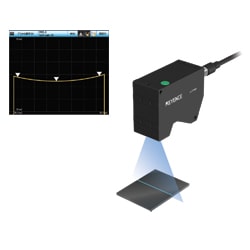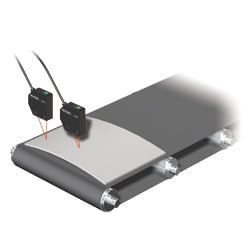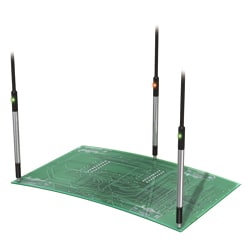Warpage / Flatness
Warpage is generally measured by detecting a target at three points.
Measurement is also possible by moving a target with a point-type sensor, or by directly measuring the shape by projecting a laser in a horizontal line.
Depending on measurement conditions and targets, methods may differ and special arrangements can be made, so contact your nearest sales office with any questions.
Light-Cut Method
LJ Series
Shapes are directly measured by exposing the target to a line laser. Warpage is then measured using the measured waveform data. By moving the target while scanning it is also possible to make measurements of 3D shapes.
Point of selection
- Possible to measure 2D height within a line
- Unlimited target selection at ultra-high speeds
- Ability to output waveform data
Ultra-High Speed In-line Profilometer
LJ-V Series
Triangulation Reflection Method
LK Series
After scanning a target using an reflective type measurement instrument, the warpage is measured using the height data of any three points. The LKG Series offers ultrahigh speed sampling, allowing for stable measurements even if the target is moving.
Point of selection
- Target selection not determined by transparency/opacity or colour
- Non-contact measurement possible
- Small beam spot and high speed
Ultra High-Speed/High-Accuracy Laser Displacement Sensor
LK-G5000 Series
Contact-Type
GT Series
To measure warpage, contact sensors are used for detection at three points.
Measurement can be easily performed by setting the warpage measurement mode using the calculation function of the GT2 Series instrument.
Point of selection
- Target selection only determined by solidity
- High-precision measurement possible
High-Accuracy Digital Sensor
GT2 Series







